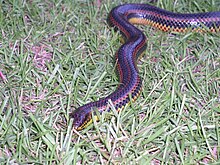Farancia erytrogramma
| Farancia erytrogramma | |
|---|---|
 |
|
| Scientific classification | |
| Kingdom: | Animalia |
| Phylum: | Chordata |
| Class: | Reptilia |
| Order: | Squamata |
| Suborder: | Serpentes |
| Family: | Dipsadidae |
| Genus: | Farancia |
| Species: | F. erytrogramma |
| Binomial name | |
|
Farancia erytrogramma (Palisot de Beauvois, 1802) |
|
| Synonyms | |
|
|
Farancia erytrogramma (also known as the rainbow snake, and less commonly, the eel moccasin) is a species of large, nonvenomous, highly aquatic, colubrid snake, which is endemic to coastal plains of the southeastern United States.
The specific name, erytrogramma, is derived from the Greek words ερυθρóς (erythros), meaning "red," and γράμμα (gramma), meaning "line."
Other common names for F. erytrogramma include horn snake, mud snake, red-lined snake, red-lined horned snake, red-sided snake, sand hog, sand snake, and striped wampum.
Rainbow snakes have smooth, glossy bluish-black back scales, with three red stripes. They have short tails, with a spiny tip which they sometimes use as a probe. Adults may show yellow coloration along the sides and on the head.
They usually grow to a total length (including tail) of 36-48 inches (91–122 cm), although some specimens have been recorded up to 66 inches (168 cm) in total length. Females are larger than males.
Rainbow snakes are rarely seen due to their secretive habits. They spend most of their lives in the water, hiding in aquatic vegetation or other forms of cover. They are strong swimmers, and also know how to burrow into mud and sand. Rainbow snakes are not aggressive when captured, and do not bite their captors.
In New Kent County, Virginia, they are abundant in sandy fields near the Chickahominy River, and great numbers are turned up by plows in the spring.
Rainbow snakes subsist mainly on eels, but also prey on small frogs, tadpoles, and salamanders. They eat their prey alive, usually swallowing them head first.
Female rainbow snakes usually lay their eggs in July, leaving them underground in sandy soil. A clutch consists of around 20 eggs on average, but large females may lay over 50. The young are hatched in late summer or fall.
...
Wikipedia

